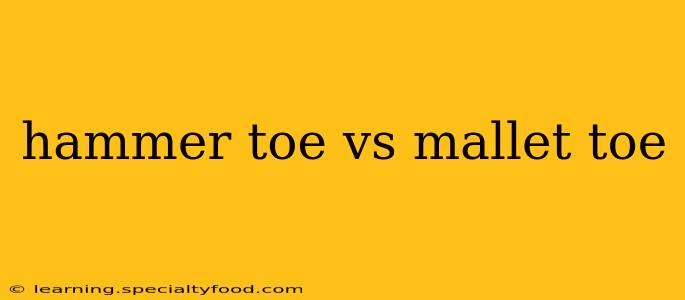Hammer toe and mallet toe are both deformities of the toes, characterized by a bent or crooked shape. While they share similarities, understanding their key differences is crucial for proper diagnosis and treatment. This comprehensive guide will delve into the specifics of each condition, highlighting their unique characteristics and answering common questions.
What is Hammer Toe?
Hammer toe affects the middle joint of the toe, causing it to bend abnormally at a right angle. This bending can occur in any toe, but it's most common in the second, third, or fourth toes. The deformity is often caused by an imbalance in the muscles and tendons that control toe movement, often stemming from ill-fitting footwear, underlying medical conditions, or injuries. The tip of the toe might point up or down. Over time, the bent joint can become stiff and painful.
What is Mallet Toe?
Mallet toe, unlike hammer toe, affects only the top joint of the toe, near the toenail. This joint bends downward, creating a claw-like appearance. The middle joint of the toe generally remains unaffected. Similar to hammer toe, mallet toe is often caused by muscle imbalances, ill-fitting shoes, or injuries. The condition can also be a symptom of neurological disorders or rheumatoid arthritis.
What Causes Hammer Toe and Mallet Toe?
Both hammer toe and mallet toe frequently share similar causes, including:
- Ill-fitting footwear: Shoes that are too tight, narrow, or high-heeled can put undue pressure on the toes, forcing them into unnatural positions.
- Muscle imbalances: Weaknesses or imbalances in the muscles and tendons of the foot can lead to abnormal toe positioning.
- Injuries: Trauma to the toe can cause damage to the muscles, tendons, or ligaments, resulting in deformity.
- Arthritis: Conditions like rheumatoid arthritis can cause inflammation and joint damage, contributing to toe deformities.
- Neuropathy: Nerve damage, often associated with diabetes, can affect muscle control and lead to both hammer and mallet toes.
- Genetic predisposition: A family history of hammer toe or mallet toe can increase your risk.
What are the Symptoms of Hammer Toe and Mallet Toe?
Symptoms for both conditions can overlap but the location of the bend is key to differentiating them. Common symptoms include:
- Pain: Pain in the affected toe, often worse with wearing shoes.
- Calluses and corns: These develop on the top of the bent joint and the tip of the toe due to friction and pressure from shoes.
- Inflammation: The affected joint may become swollen and tender.
- Limited toe mobility: Difficulty straightening the affected toe.
- Deformity: Visible bending of the toe.
How are Hammer Toe and Mallet Toe Treated?
Treatment options for both conditions depend on the severity of the deformity and the presence of pain. Conservative treatments include:
- Orthotics: Custom-made shoe inserts to support the arch and improve foot alignment.
- Padding: Protective pads to cushion the affected area and reduce friction.
- Pain relievers: Over-the-counter pain medications like ibuprofen can help manage pain and inflammation.
- Shoe modifications: Wearing wider, more comfortable shoes with enough room in the toe box.
More aggressive treatments may be necessary in severe cases, including:
- Splints: To gently correct the toe's alignment.
- Surgery: In cases where conservative treatments fail or the deformity is severe.
Can Hammer Toe Turn into Mallet Toe (or vice versa)?
Hammer toe and mallet toe are distinct conditions affecting different joints of the toe. While one condition doesn't directly transform into the other, the underlying causes (such as muscle imbalance or ill-fitting shoes) can contribute to the development of both conditions simultaneously or separately over time. If left untreated, a hammer toe can worsen, potentially leading to further complications and possibly affecting the top joint and mimicking some aspects of a mallet toe. However, the specific joint affected remains the defining difference.
How are Hammer Toe and Mallet Toe Diagnosed?
Diagnosis typically involves a physical examination by a podiatrist or other healthcare professional. The doctor will examine the affected toe, assessing its shape and mobility. In some cases, X-rays may be used to confirm the diagnosis and rule out other conditions.
What is the Prognosis for Hammer Toe and Mallet Toe?
With early diagnosis and treatment, the prognosis for both conditions is generally good. Conservative measures are often effective in managing symptoms and preventing further deformity. However, if left untreated, the condition can worsen, leading to increased pain, calluses, and potentially surgery. Regular podiatric care and attention to footwear are essential for long-term management.
This information is for general knowledge and does not constitute medical advice. Always consult with a healthcare professional for diagnosis and treatment of any foot or toe condition.
